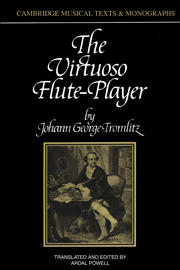Book contents
- Frontmatter
- Contents
- Translator's note
- Introduction by Eileen Hadidian
- Title in the series
- DETAILED AND THOROUGH TUTOR FOR PLAYING THE FLUTE
- Foreword
- Introduction
- 1 The flute and its character
- 2 Holding the flute, and the embouchure
- 3 Fingering
- 4 The notes and rests, their values and denominations, and the other musical signs
- 5 Time-signatures, and how the notes are divided and counted in them; the beat itself, or counting time according to an appointed tempo
- 6 Tone and pure intonation
- 7 Modern key-signatures
- 8 The articulation proper to this instrument, or the means of governing the wind suitably, as well in slow as in moderately quick movements; also called the single tongue
- 9 The technique for executing fast and very fast passages clearly and roundly; also, though improperly, called the ‘double tongue’
- 10 The ornaments
- 11 The trill
- 12 Fermatas and cadenzas
- 13 The taking of breath in flute-playing
- 14 The discretionary ornaments; or how to vary a simple melody according to the rules of harmony, and to use these variations in a good and suitable way appropriate to the material
- 15 Summary of the whole, together with a few remarks for pupils and masters
- Fingering-chart
- Select bibliography
- Index
8 - The articulation proper to this instrument, or the means of governing the wind suitably, as well in slow as in moderately quick movements; also called the single tongue
Published online by Cambridge University Press: 01 June 2011
- Frontmatter
- Contents
- Translator's note
- Introduction by Eileen Hadidian
- Title in the series
- DETAILED AND THOROUGH TUTOR FOR PLAYING THE FLUTE
- Foreword
- Introduction
- 1 The flute and its character
- 2 Holding the flute, and the embouchure
- 3 Fingering
- 4 The notes and rests, their values and denominations, and the other musical signs
- 5 Time-signatures, and how the notes are divided and counted in them; the beat itself, or counting time according to an appointed tempo
- 6 Tone and pure intonation
- 7 Modern key-signatures
- 8 The articulation proper to this instrument, or the means of governing the wind suitably, as well in slow as in moderately quick movements; also called the single tongue
- 9 The technique for executing fast and very fast passages clearly and roundly; also, though improperly, called the ‘double tongue’
- 10 The ornaments
- 11 The trill
- 12 Fermatas and cadenzas
- 13 The taking of breath in flute-playing
- 14 The discretionary ornaments; or how to vary a simple melody according to the rules of harmony, and to use these variations in a good and suitable way appropriate to the material
- 15 Summary of the whole, together with a few remarks for pupils and masters
- Fingering-chart
- Select bibliography
- Index
Summary
That a certain tidiness in the management of the wind is essential to good playing on this instrument, everyone who knows anything at all about performing will understand and admit. An airstream ungoverned by rules could produce neither melody nor passages clearly, comprehensibly and with expression; or if the wind were not regulated at all, but just allowed to come straight out, as for the most part is the case, everything would sound stuck together and droning, and consequently even less clear – as Quantz says: like a bagpipe. This is easier to understand if one imagines how it would sound if a whole phrase or a whole passage were played with a single bow-stroke on a stringed instrument. Now since this is not the way to do it, but instead the bow must be moved according to rules and in an artful way suited to the nature of the melody and the passages, it can easily be understood that on wind instruments a similar motion of the wind according to rules must be required if the performance is not to be defective and incomprehensible. But this regulated motion of the wind can be effected solely by the tongue, holding back or giving free passage to the air, as occasion and the rules demand. In a comparison between the violin and the flute, it will be found that what the bow is to the violin, the wind is to the flute, and what the arm, governing the bow, is to the former, the tongue, governing the wind, is to the latter.
- Type
- Chapter
- Information
- The Virtuoso Flute-Player , pp. 150 - 194Publisher: Cambridge University PressPrint publication year: 1991



